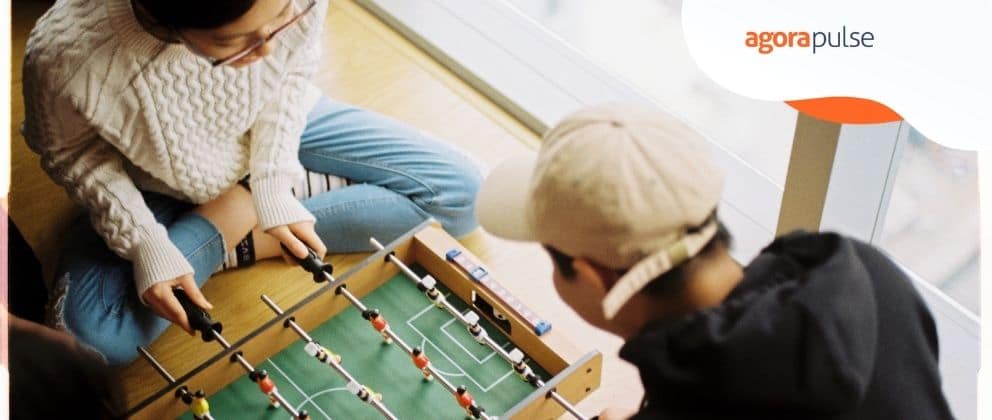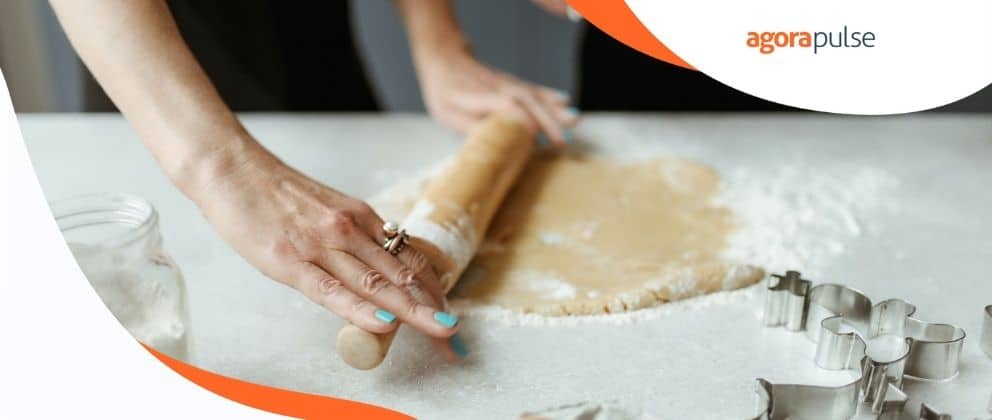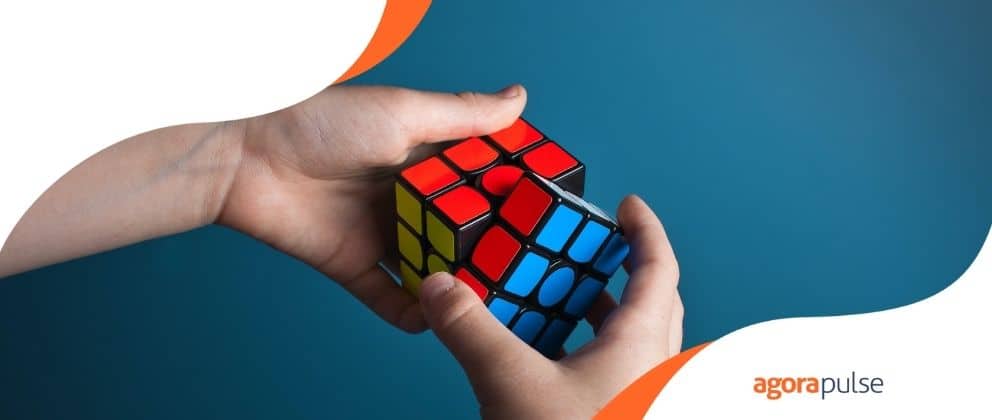Wondering what the correct social media image sizes are? It can be tiring for social media managers to keep up with the constant changes. No worries, though—we’ve got that covered for you.
This guide is your go-to reference to figure out what size each asset should be, along with some pro tips for making these images work for you.
Moreover, 80% of social media views are from mobile devices, so understanding how image sizes display differently on mobile vs. desktop is important too.
Taking a little bit of time to customize your social media to each channel can yield big results.
Facebook is still the biggest social media platform in terms of average daily users. In fact, 1.79 billion (yes with a B!) people log onto Facebook on an average day, according to Zephoria. With its recent platform updates, you will want to make sure you are putting your best foot forward.
Let’s look at a summary of all the specs, and then dive into what that means for your design.
- Profile picture: Displays at 170 x 170 pixels, 128 x 128 pixels on smartphones and on most other phones 36 x36; square image size, cropped into a circle on Facebook
- Page cover: Minimum 400 x 105 pixels, displays at 820 x 312 pixels on the desktop; cropped to the middle 640 x 360 pixels on mobile phones
- Video page cover: Minimum 820 x 312 pixels; recommended 820 x 462 pixels
- Facebook video thumbnail: Recommended 1,280 x 720 pixels
- Newsfeed post: Recommended 1,080 x 1080 pixels (but can go as low as 600 x 600 pixels)
- Facebook event banner: 1,200 x 628 pixels (Make sure to preview in desktop and mobile view for best results.)
Profile picture

Social media image sizes: Facebook profile picture
On a computer, your profile picture will display 170 x 170 pixels. On smartphones 128 x 128 px, and on standard phones 36 x 36 px.
Remember that if someone clicks on the photo to open it, it will be larger.
If you are able to make the photo larger, ensure it is a high-quality photo wherever people see it. You will always want it to be a square aspect ratio.
When choosing a design, keep in mind that Facebook will crop it into a circle, so any text or important elements need to be within the circle.
Cover image

Social media image sizes: Facebook cover image
Ideal sizes for the cover image on Facebook can get a little confusing.
Though you can make an image that is as small as 400 x 100 px, you are better off going for the recommended 851 x 315 if you can.
Remember that your cover image will display differently on a computer vs. on mobile.
On a mobile device, your image will display at 640 x 360, so only the middle 640 pixels will be visible.
Since a large number of visitors to social media do so on their phones, design for it with the proper social media image sizes.
This is a great example of a brand that has centered the image for better viewing on mobile:

Facebook image cover size for mobile
Want to know what else is awesome about that cover image? It is actually a video!
One of the most underutilized options for Facebook cover images is to actually use a video instead.
You can feature an interview with your team, show off your products, display your best-performing ad, or create a direct invitation to like your page.
There is just one catch: It has to be an image you have already posted on your page. Rather than creating a separate video, you select from videos that fit the requirements on your page.

Choose the right image from your library.
Videos should be 20-90 seconds long and 820 x 462 px. And if this is the first thing your visitors see on your page you will want to make sure that it has a thumbnail image and captions, too.

Image size for the thumbnail of your video
For thumbnail size, you can design it the same way you would for a YouTube thumbnail:1280 x 720 px, or a 16:9 aspect ratio.
Using a custom thumbnail can make a big difference in getting video views on Facebook!
If a video feels like too much, another alternative is a slideshow.
You can add up to 5 different photos that display in a slideshow format. Though the first image will still get most of the views, you can maximize this space to show off products, testimonials, or other key information.

Let Facebook choose photos.
Post size
When creating your Facebook image for your newsfeed, you have a lot of flexibility.
But there are still some important guidelines to know:
- Ratios from 1.91:1 to 4:5 are supported.
- Recommend at least 1080 x 1080 pixels
- Minimum 600 x 600 pixels
- Maximum file size 30MB
In other words, you can be creative! Try to keep in mind everything you know about your ideal audience and what kind of images they will love to see.

Social media image sizes: example
Facebook event banner

Size for a Facebook event banner
Facebook has updated its events in a lot of ways, such as to facilitate online events, paid events, and connect Eventbrite tickets to your event.
But whatever kind of event you are doing, you will need to add a Facebook Event Banner image.
Facebook recommends that your image is 1,200 x 628 pixels. But just like the Facebook page cover, it will look different if you are on a computer vs. mobile device.
The nice thing about the Event banner is that Facebook gives you the option to toggle between both views. So you can make sure it looks good either way and tweak it before publishing.

Preview desktop and mobile views
- Profile picture: Minimum 110 x 110 pixels; recommended 170 x 170
- Post size: 1,080 x 1080
- Story size: 1,080 x 1920
- Story highlight image: 1,080 x 1920 pixels, with the center circle visible
Profile picture

Social media image sizes: Instagram profile pic
If you don’t add a profile picture, and you connect your Instagram and Facebook accounts, then Instagram will use your Facebook profile picture.
Because Instagram is an almost exclusively mobile platform, you can also go smaller on your Instagram profile picture if you want. As low as 110 x 110 pixels will still look great on mobile devices.
Like several of the other profile picture sizes, the square image will be cropped to a circle on this platform.
Post size

Ideal social media image size for Instagram post
Technically any square image at least 600 x 600 pixels will do, but Instagram is all about making those images look great.
In other words, go big or go home: 1,080 x 1,080 pixels is a perfect size for Instagram posts on your Timeline.
Story image
You are able to create stories with images that are anywhere from 1:9 to 9:16 but often the image will end up being small with a lot of background making up the difference.
You will get better results if you design images specifically for stories (in this case, the mobile ratio of 9:16 or 1,080 x 1,920 pixels).
Of course, don’t forget that images are just the start of stories. Stickers, polls, and live video are all worth exploring!
Story highlight image

Instagram profile pic
Story highlights are an amazing way to categorize your content and help your stories still be available for your audience. You can even use highlights to create product categories for sales. You have the option to set any of your stories in a highlighted category as the image, or you can make custom images, like the example above. Personally, I think the customized images look incredibly professional and almost turn your Instagram into a mini-website for users to browse. The story highlight images are the same size as stories in general, but only a circle from the story will show up.
- Profile picture: Minimum 400 x 400 pixels, maximum 8MB file size
- Personal profile cover image: 1,584 x 396 pixels, PNG or JPG, 8MB or smaller
- Business profile picture: 300 x 300 pixels, square
- Page cover image: Minimum 1,192 x 220 pixels; recommended 1,128 x 191 pixels
- Post size: 1,200 x 1,200 pixels or 1,200 x 627 for link images
- LinkedIn publishing banner image: 2,000 x 600 pixels
- Group logo: Minimum 60 x 60 pixels; (Must be a square image)
- LinkedIn group banner: 1,776 x 444 pixels
Profile picture

Social media image sizes: LinkedIn profile pic
Like many other social media profiles, your LinkedIn personal profile image is a square image that will be cropped to a circle.
Unlike other platforms, LinkedIn provides a lot more image editing within its platform.
You can:
- Edit colors
- Straighten
- Add filters
- Crop to the right size (even for a non-square original image).
If you want to make it easy, upload your 400 x 400 px profile image from your other social media accounts and call it good.
Cover image

Size for LinkedIn cover image
Most people on Twitter and Facebook take the time to upload a banner image, but it amazes me how many people on LinkedIn miss this opportunity to up-level their professionalism and clarify their personal branding.
Just like on Twitter, the top and bottom may be trimmed depending on the device you are viewing the profile on, so it is best to include any text or logos centered and to the right of the image.
Your design should be 1584 x 396 pixels, and can only be a JPG or PNG.
LinkedIn does not support GIF files.
Business logo and banner image

Image size for LinkedIn Business Profile
Unlike personal profiles, the logo on a business page shows up as a square image. You will want to use a 300 x 300 pixel logo file that is PNG or JPG.
The banner image is also very different than personal profiles: wide and thin at 1,128 x 198 pixels.
Use this space to show off your brand and make people excited to follow you!
Post size
LinkedIn doesn’t provide very clear instructions on what social media image sizes will do best, but it does give some guidance.
Images should be at least 1,200 pixels wide. And if you are customizing an image to go with a URL link, then 1200 x 627 is recommended.
Because the longer image will still show the whole image, choosing a 1,200 x 1,200 for your image posts can be the best option to get you the most visibility on your connections’ timelines.

Publishing banner image
If you are not using LinkedIn Publishing … what is holding you back? Diving into this content medium can provide you a whole new audience on LinkedIn! And you want to make sure you are including a header image for your post when you write it.

Social media image size for LinkedIn publishing banner
Your image should be 2,000 x 600 pixels and less than 10MB.
But the whole width of the image will not show up everywhere.
Only the middle 1,200 pixels will show up in your featured image and other post types when you share. Using an image only or making sure to position any text in the center of the image will ensure that it looks good wherever it appears on the platform.

Group logo and banner
Are you creating LinkedIn Groups? If so, you will find totally different requirements for the logo and banner image for groups.

LinkedIn Groups banner social media image size
In addition to the smaller logo size (92 x 92), you will want to create a banner that is 1776 x 444 and accommodates for logo covering the bottom left corner of the image.
Unlike Facebook, which includes a lot of variability, Twitter is pretty straightforward.
If you can keep some key design numbers for the different social media image sizes in mind, you will be all set.
- Profile picture: 400 x 400 pixels
- Cover image: 1,500 x 500 pixels (the top and bottom 60 pixels may be cut off)
- Post size: 1,200 x 675 pixels (16:9 ratio) or larger, under 5MB
- Twitter GIF: 1,280 x 1080 pixels, under 15 MB, fewer than 350 frames
Profile picture and cover image

Social media image sizes: Twitter profile
Your profile picture should be a standard 400 x 400 pixels.
Like on Facebook, it will be cropped into a circle, so consider that when you are choosing a design. Twitter supports JPEG, PNG, and GIF formats and maximum file size of 2MB for the profile photo.
Header images should be 1,500 x 500 pixels.
The good news is that you need to do less adjusting for desktop vs. mobile designs than you do on Facebook.
Twitter does advise that the top and bottom 60 px may be cut off on different devices. Simply leave yourself a decent amount of header and footer room. And the profile picture will cover some of the image in the left bottom corner.
Post image size
What you CAN do and what you SHOULD do with your image sizes on Twitter posts are two different things.
While Twitter will support posts as low as 600 px wide, it recommends 1,200 px width minimum. So, if someone clicks on your post, or embeds your tweet, it will still show up well.
Likewise, watch out for your ratios.
You can create any aspect ratio between 2:1 and 1:1, and it may be tempting to save time and use the same square images you posted on Instagram or Facebook.
But even though you will be able to post it, anything taller than a 16:9 ratio will be cropped to fit into those dimensions on a mobile device (so, most viewers).

Social media image sizes: Twitter post
Rather than get your post cropped in a weird place, you are better of sticking to at least 1,200 pixels wide, in a 16:9 format. In other words: 1,200 x 675 px (or a larger 16:9 ratio).
Whatever image resolution you use, you will need to keep the file (JPG, PNG, GIF, WEBP) under 5MB for an image and under 15MB for a GIF.
While on the topic of GIFs, there are a few other requirements to keep in mind. Your image size should be 1200 x 1080 pixels or less, and the file must have fewer than 350 frames.

YouTube
YouTube has updated its customization options significantly over the years. Now you can watermark your images, brand your thumbnail images, and add channel art, among other things.
- Profile picture: Minimum 98 x 98 pixels or larger, PNG or static GIF, 4MB or smaller
- Channel header: 2,048 x 1152 pixels, 6MB or smaller; recommended 2,560 x 1,440
- Video thumbnail: 1,280 x 720 pixels
- Video watermark: 150 x 150 pixels, 1MB or smaller
Profile picture

Do you know the ideal size for a YouTube profile pic?
Remember that in most places your YouTube profile picture will show up pretty small (comments for example). That is why it only needs a picture that is 98 x 98 pixels. Of course, you can go bigger if you still keep the file size under 4MB.
Channel Header
Like the banner image on LinkedIn, YouTube channel art is often underutilized by novices to the platform.
Creating clear branding on your channel is a key step to building a following over time, so don’t skip this step!

YouTube channel header image
YouTube recommends an image that is 2048 x 1152 pixels and less than 6MB. And good news: The channel art displays in a pretty consistent way between mobile and desktop versions.
Because the profile picture is below the image, it doesn’t interfere with the design either.
Video thumbnail
If you take the time to make great videos, give yourself the best chance of your audience watching them, too.
Thumbnails are a quick and easy way for people to understand what the video is about and why they should watch it.

YouTube thumbnail images
You can save yourself some work here and make a single thumbnail image for Facebook and YouTube because they are both ideally 1,280 x 720 pixels.
Cross-posting your videos from one platform to another can help you grow your audience and number of views.
Video watermark

YouTube video watermark
Anyone who has been creating content for a while knows the frustration of someone stealing your content. (Don’t be that guy!) You can make this just a little harder to do by adding a 150 x 150 pixel watermark that YouTube will automatically add to all your videos.
Conclusion
Are all your profiles up to date? If not, now might be a great time to do a social media audit and see how you can get back on track!
* * *
Get started on saving time and energy on your own social media management! Check out our free trial of Agorapulse to help you schedule, track, and measure all your social media efforts.





